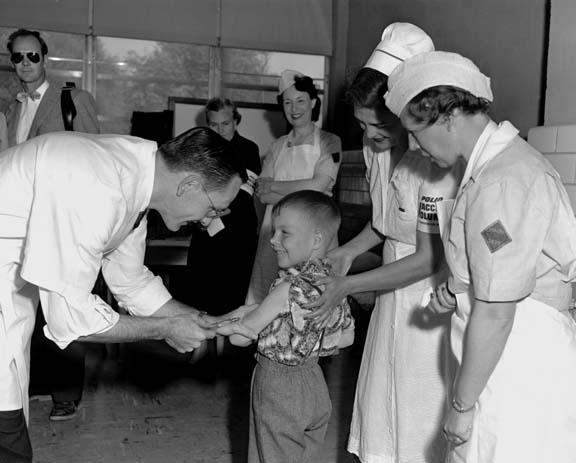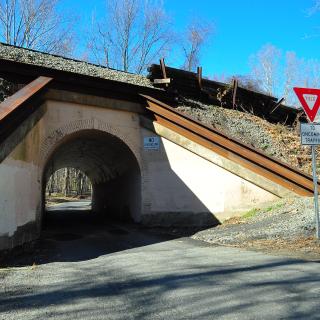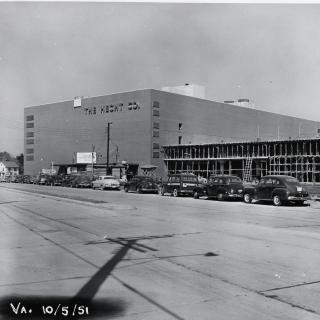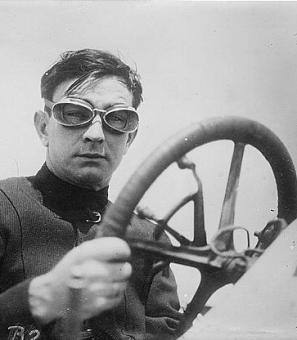"The Shot That Was Felt Around the World": McLean's Polio Pioneers
April 26, 1954, wasn’t an ordinary day at work for Dr. Richard Mulvaney. As McLean, Virginia’s first general practitioner,[1] he treated all types of patients, but he’d never dealt with a situation like the one that awaited him at Franklin Sherman Elementary School that morning.
“There were a lot of reporters, TV cameras and kids out in the hall screaming,”[2] Mulvaney recalled 50 years later, remembering the scene as he entered the school cafeteria. Indeed, the events about to take place at Franklin Sherman Elementary School were headline news. The school had been selected to kick off a nationwide Polio vaccine trial aimed at finally eradicating the dreaded disease. Over the course of about two hours that morning, Mulvaney administered shots of a promising trial vaccine to 114 2nd graders.[3]
It’s difficult to overestimate the fear that Polio engendered in America during the mid-20th century. A highly contagious viral disease that primarily impacts the nervous system of young children, it can lead to paralysis or death.[4] For decades, scientists studied poliomyelitis but a vaccine remained elusive. Periodic outbreaks — including one in 1952 that infected over 57,000 Americans — continued.[5] The image of young patients with paralyzed chest muscles lying in respirators known as “iron lungs”[6] was imprinted on the nation’s collective psyche.
“It was so frightening,” recalled Gail Batt, one of the students who received the trial vaccine. “Your first image was children just like you lying down flat on their back inside this big iron lung, and it looked like a metal cylinder. All you could see were their heads and their eyes looking out, and that’s what you always thought about with Polio were these iron lungs, and you didn’t want to end up in an iron lung. ... It was so scary. It was the scariest thing that was going around at that time.”
The road to the vaccine trial at Franklin Sherman Elementary School started over a decade earlier. In 1938, President Franklin Roosevelt, who contracted Polio in 1921,[7] founded the National Foundation for Infantile Paralysis.[8] It soon became known as the “March of Dimes,” after a radio address asking people to donate a dime spurred more than $268,000 in donations.[9] In 1951, the foundation gave Dr. Jonas Salk, a researcher at the University of Pittsburgh, a grant to work on a Polio vaccine.[10]
Salk came up with a Polio vaccine made from a “killed virus.” To do this, he killed the living poliovirus with formaldehyde so it was no longer infectious, but it still invoked an immune response in patients. He tested the vaccine on his wife and children in 1953.[11] A preliminary trial with around 7,500 children in the Pittsburgh area deemed the vaccine safe and allowed plans for a nationwide trial to move forward the following year.[12]
National Foundation for Infantile Paralysis officials initially tapped Montgomery County, Maryland, Alexandria, Arlington, and Fairfax Counties in Virginia, and Washington, D.C. to participate in the nationwide trial, and it was scheduled to start in Washington, D.C.[13] However, as the late April start date approached, some local jurisdictions began to waver.
On March 9, 1954, DC Health officials announced they weren’t participating in the trial for three reasons: uncertainty about the vaccine’s safety, a generally low incidence of Polio in D.C., and concerns there wouldn’t be enough time to complete the trial before school let out for the summer.[14] Just a few weeks later, the director of the Maryland Department of Welfare announced that Montgomery County wouldn’t participate in the trial either.[15]
“The State Advisory Committee ruled that conducting the trial in April would be inadvisable because of the ‘normal seasonal increase in polio which may be expected during May and June,’” read a March 27 page one article in The Washington Post.[16]
A couple of weeks later, Alexandria was out. Officials there said the decision came because Alexandria’s Polio season started April 1 and, thus, the timing of the trial was too late.[17] Arlington dropped out a few days later.[18]
In early April, just a few weeks before the trial was scheduled to begin, broadcaster Walter Winchell told his radio and TV audience the new Polio vaccine “may be a killer.” He claimed a batch of the vaccine contained live, not killed poliovirus.[19] It’s difficult to say what impact, if any, Winchell’s comments had on officials making the decisions, but they underscore concerns held by some at the time. As safe as Salk’s vaccine appeared to be, Polio was terrifying.
Even as the other local jurisdictions bowed out, Fairfax County pressed forward with preparations for the trial. Starting April 7, the Fairfax County Health Department conducted a series of meetings at 10 schools to explain the trial to parents.[20] In a crowd of about 300 parents at Annandale Elementary School, “practically every hand was raised when one father asked how many present were willing to have their children receive the test vaccine injections.”[21]
In order for their children to participate, parents had to sign a consent form. The forms were due April 20,[22] but by April 16, Fairfax County received consent for 2,336 students to participate, and county officials ordered enough vaccine for 2,600 students.[23]
There was one final hurdle before the nationwide trial could begin. Over the weekend of April 24–25, National Foundation for Infantile Paralysis officials and Polio researchers including Salk, met at the Statler Hotel in Washington D.C, to determine if it was safe to conduct the trial. The trials wouldn’t begin unless the foundation gave the go-ahead.[24]
According to The Washington Post, Dr. Hart Van Riper, medical director of the National Foundation for Infantile Paralysis, said the vaccine committee would “inquire into the manufacturing of the vaccine, the various tests it goes through, and all its other aspects,” before deciding if it was safe to move forward.[25]
On Sunday, the decision was made. The trial would begin the next morning, and according to the national timetable, it would start at Franklin Sherman Elementary School.[26]
At 9 a.m., Dr. Mulvaney administered what one March of Dimes official would later call “the shot that was felt around the world”[27] to six-year-old Randall Kerr. The young patient had poison ivy, but he spent the week leading up to the moment asking to go first, and apparently, his pleas were heard.[28] A photo of Kerr, Mulvaney, and a registered nurse, Mrs. John Lucas, appeared in Monday’s edition of The Evening Star.[29]
“I could hardly feel it,” Kerr told reporters that day. “It didn’t hurt as much as a Penicillin shot.”[30]
Not everyone had the same reaction. Batt remembers a boy in line with her fainting and collapsing onto the floor.
Of the 114 2nd grade students who received a shot from Mulvaney that morning, 82 went to Franklin Sherman Elementary School.[31] The remainder were enrolled at other public, private, and parochial schools in the area.[32]
As Batt recalled, the trial was a big deal.
“My mom said she volunteered me,” Batt said. “She wanted to be brave like Eleanor Roosevelt who she greatly admired. ... They just told me that I was going to get a shot, I didn’t like shots, and I can remember thinking, I was proud. I was proud I’d been selected even though I didn’t like shots.”
Batt doesn’t remember much about the day, but she said after the shot she went with some of the other students to get an ice cream sundae. “It was all a big adventure,” she said.
All of the 2nd grade participants at Franklin Sherman Elementary School received the vaccine, and some 1st and 3rd graders participated as controls. They didn’t receive an injection, but their vitals were recorded so researchers could later compare them to students who received the vaccine. Following the vaccinations, some of the 2nd graders also had a blood test so researchers could study their immune response to the vaccine.[33]
The vaccine trial consisted of a series of three shots, with the second one given a week after the first, and the last one coming a month later.[34] Franklin Sherman Elementary School holds the distinction of hosting the first trial vaccinations, but during the week of April 26, at least 4,000 students[35] and 39 doctors at more than 40 schools in Fairfax County took part in the trial.[36] The students were just a few of the more than one million participants across 45 states. Collectively, the children became known as the “Polio Pioneers.”[37]
Less than one year after that morning in the Franklin Sherman Elementary School cafeteria, on April 12, 1955, all eyes were on the University of Michigan where researchers were set to announce the results of the trial. At 10:20 a.m., one of Salk’s mentors, Dr. Thomas Francis Jr., announced the trails had been a success and he declared the vaccine, “safe, effective, and potent.”[38] Later that month, children in D.C., Maryland, and Virginia began to receive the vaccine.[39] Within 15 years, the United States eliminated Polio.[40]
On the 50th anniversary of the beginning of the trial, Mulvaney, Batt, and a few other Polio Pioneers returned to the Franklin Sherman Elementary School cafeteria along with Centers for Disease Control and Prevention and March of Dimes representatives to commemorate their role in the search for a Polio vaccine.[41]
“I wasn’t prepared for the reaction, but we all do feel we were a part of history,” Mulvaney said in 2004. “When the vaccine came, the number of cases of Polio dropped dramatically. It was great being a part of that.”[42]
Footnotes
- ^ Patricia Sullivan, “Richard Mulvaney,” Washington Post, November 3, 2006, https://www.washingtonpost.com/archive/local/2006/11/03/richard-mulvane….
- ^ “Polio Vaccine’s Proud Pioneers,” www.connectionnewspapers.com, April 28, 2004, http://www.connectionnewspapers.com/news/2004/apr/28/polio-vaccines-pro….
- ^ “Fairfax 2d Graders Receive Shots in Polio Vaccine Test,” The Evening Star, April 26, 1954.
- ^ “Poliomyelitis (Polio),” www.who.int, n.d., https://www.who.int/health-topics/poliomyelitis#tab=tab_1.
- ^ “Reported Paralytic Polio Cases and Deaths in the United States since 1910,” Our World in Data, https://ourworldindata.org/grapher/reported-paralytic-polio-cases-and-d….
- ^ Roger Wollenberg, 50TH ANNIVERSARY OF POLIO VACCINE CELEBRATED, April 26, 2004, UPI, April 26, 2004.
- ^ Amy Berish, “FDR and Polio - FDR Presidential Library & Museum,” Fdrlibrary.org, 2016, https://www.fdrlibrary.org/polio.
- ^ Franklin Roosevelt, September 23, 1937.
- ^ “Origin of Our Name,” www.marchofdimes.org, https://www.marchofdimes.org/mission/eddie-cantor-and-the-origin-of-the….
- ^ Michael Ruane, “The Tainted Polio Vaccine That Sickened and Fatally Paralyzed Children in 1955,” Washington Post, April 14, 2020, https://www.washingtonpost.com/history/2020/04/14/cutter-polio-vaccine-….
- ^ Michael Ruane
- ^ “Polio Tests Get Green Light as Vaccine Is Ok’d,” The Evening Star, April 26, 1954.
- ^ Robert P Jordan. “Polio Officials to Decide Fate of Vaccine at Meeting here.” The Washington Post, Apr 19, 1954.
- ^ “D.C. Officials Veto Tests of Polio Vaccine,” The Washington Post, March 9, 1954
- ^ “Montgomery Polio Test Called Off,” The Washington Post, March 27, 1954.
- ^ “Montgomery Polio Test Called Off”
- ^ “Arlington Polio Test In Doubt,” The Washington Post, April 10, 1954.
- ^ “Arlington Doctors Put Off Polio Tests In Schools Until Fall,” The Evening Star, April 16, 1954.
- ^ “Paranoid Gossip about Polio Vaccine,” Scientific American, 1954, https://www.scientificamerican.com/article/paranoid-gossip-about-polio-….
- ^ “Polio Test to Be Explained in Fairfax,” The Washington Post, April 3, 1954
- ^ “Meeting of Parents Virtually Unanimous for Polio Shots,” The Evening Star, April 8, 1954.
- ^ “Parents Get Forms Today in Polio Test,” The Evening Star, April 9, 1954.
- ^ “Polio Test OK’d By 58 Pct. of Fairfax Parents,” The Evening Star, April 16, 1954
- ^ Robert P Jordan
- ^ Robert P Jordan
- ^ Nate Haseltine, “Committee Gives Green Light for Polio Shots,” The Washington Post, April 26, 1954.
- ^ “Polio Vaccine’s Proud Pioneers”
- ^ William Smith, “Salk Polio Test Starts in Fairfax,” The Washington Post, April 27, 1954.
- ^ “Polio Tests Get Green Light as Vaccine Is Ok’d”
- ^ William Smith
- ^ “Fairfax Readies Polio Vaccine Tests on 2,396,” The Evening Star, April 25, 1954.
- ^ William Smith
- ^ William Smith
- ^ William Smith
- ^ “Polio Vaccine Shots Are Given at 11 More Schools in Fairfax,” The Evening Star, April 27, 1954.
- ^ “Final Polio Test Sanction Is Pondered,” The Washington Post, April 25, 1954.
- ^ David Rose, “Polio Pioneer Card | Post Polio: Polio Place,” www.polioplace.org, March 10, 2015, https://www.polioplace.org/history/artifacts/polio-pioneer-card.
- ^ “U-M School of Public Health Polio Vaccine,” sph.umich.edu, https://sph.umich.edu/polio/#:~:text=%22Safe%2C%20effective%2C%20and%20….
- ^ “Vaccine Highlights,” The Washington Post, April 13, 1955.
- ^ CDC, “Polio Elimination in the U.S.,” Centers for Disease Control and Prevention, October 25, 2019, https://www.cdc.gov/polio/what-is-polio/polio-us.html#:~:text=Thanks%20….
- ^ “Polio Vaccine’s Proud Pioneers”
- ^ “Polio Vaccine’s Proud Pioneers”






![Sketch of the mythical fuan by Pearson Scott Foresman. [Source: Wikipedia]](/sites/default/files/styles/crop_320x320/public/2023-10/Goatman_Wikipedia_Faun_2_%28PSF%29.png?h=64a074ff&itok=C9Qh-PE1)












